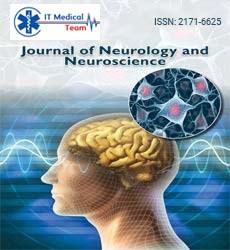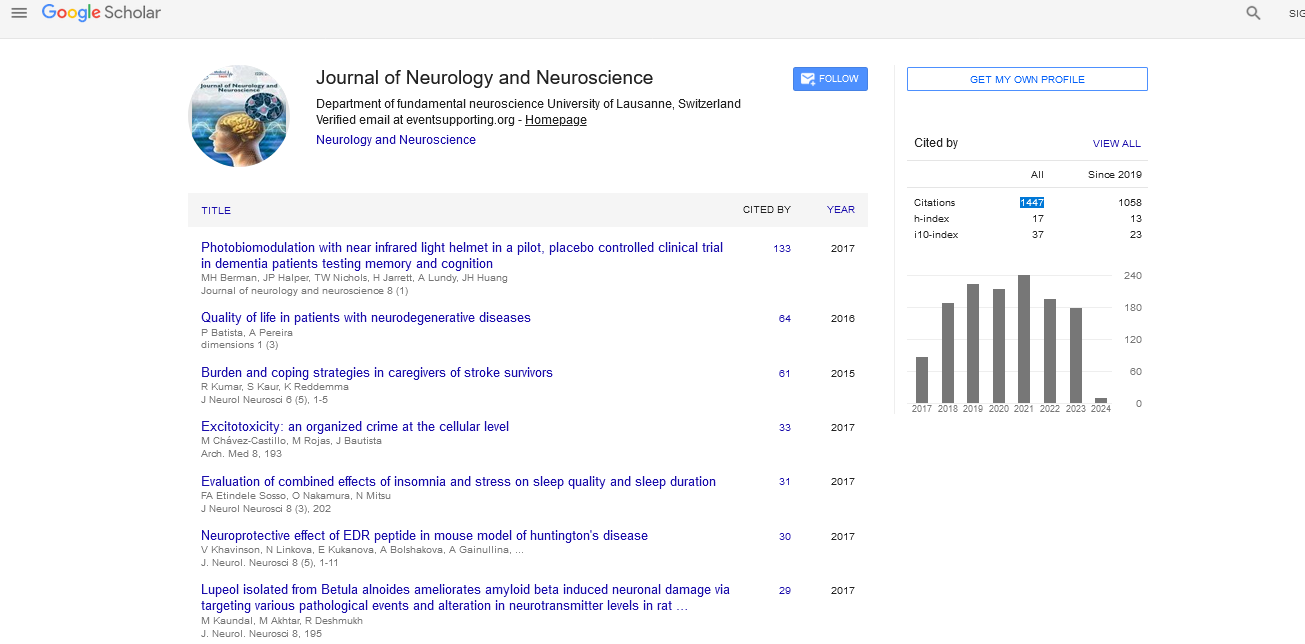Opinion - (2025) Volume 16, Issue 1
The mechanisms of alpha rhythm modulation in the cortical motor area: Insights from neural mass modeling
Messina Robinson*
Department of Neurosurgery, Xuanwu Hospital, Capital Medical University, Beijing 100032, China
*Correspondence:
Messina Robinson, Department of Neurosurgery, Xuanwu Hospital, Capital Medical University, Beijing 100032,
China,
Email:
Received: 30-Jan-2025, Manuscript No. ipjnn-25-15566;
Editor assigned: 01-Feb-2025, Pre QC No. P-15566;
Reviewed: 14-Feb-2025, QC No. Q-15566;
Revised: 20-Feb-2025, Manuscript No. R-15566;
Published:
27-Feb-2025
Introduction
Alpha rhythms are a prominent feature of brain activity,
most commonly observed in the Electroencephalogram
(EEG) in the frequency range of 8–12 Hz. These rhythms
are generally associated with relaxed, alert states,
particularly when a person is awake but not actively
engaged in cognitive tasks. While alpha rhythms are
often discussed in the context of sensory processing
and cognitive control, their role in motor control is
increasingly being recognized. The cortical motor areas,
responsible for planning, executing, and controlling
voluntary movements, are thought to be modulated by
these rhythms, influencing both motor output and motor
learning.
Understanding the mechanisms of alpha rhythm
modulation in the cortical motor area is essential for
gaining insights into how the brain coordinates motor
function. Neural Mass Modeling (NMM) is a mathematical
and computational approach that allows researchers to
simulate the collective dynamics of neuronal populations.
By applying NMM to the study of motor cortical activity,
it is possible to explore how alpha rhythms are modulated
and how this modulation relates to motor control. This
article explores the mechanisms underlying alpha rhythm
changes in the cortical motor area and how neural mass
modeling can provide insights into these processes [1].
Alpha rhythms are most prominently observed in the
posterior regions of the brain, particularly in the occipital
lobe, which is involved in visual processing. However, they
are also present in the motor cortex, particularly during
periods of rest or when motor tasks are not actively being
performed. In the motor cortex, alpha rhythms have
been shown to reflect a state of readiness or inhibition,
influencing the capacity for movement initiation and
execution. High-amplitude alpha oscillations in the motor
cortex are often linked to states of motor inhibition,
where the brain is preventing unwanted movements.
This is particularly important when maintaining posture
or when fine-tuning the coordination of ongoing
motor tasks. Lower amplitude alpha rhythms or their
suppression, on the other hand, may signal the brain’s
preparation for voluntary movement initiation. [2].
Description
Neural Mass Modeling (NMM) is a computational
approach that simulates the collective activity of large
populations of neurons. These models aim to capture
the behavior of neural systems at a macroscopic level
by using equations that describe the interactions
between different neuronal groups. NMM offers a way
to understand the dynamics of brain rhythms, including
alpha rhythms, by representing how neural populations generate oscillatory activity and how these oscillations are
modulated by external or internal inputs. In the context of
motor control, neural mass models can provide valuable
insights into how alpha rhythms are modulated during
different stages of movement. These models typically
involve simplifying assumptions about the connections
and interactions between different cortical regions, with
an emphasis on the motor cortex and its interactions
with other brain regions involved in motor control, such
as the premotor cortex, basal ganglia, and cerebellum.
The modulation of alpha rhythms in the motor cortex is
influenced by various factors, including sensory feedback,
cognitive load, and the motor task being performed.
Neural mass modeling has helped elucidate several
mechanisms by which these rhythms can be altered [3].
The balance between excitatory and inhibitory inputs
in the motor cortex plays a key role in modulating alpha
rhythms. Alpha oscillations are thought to arise from the
dynamic balance between excitatory pyramidal neurons
and inhibitory interneurons. When the inhibitory inputs
are strong, they can suppress excitatory activity, leading
to an increase in alpha rhythm amplitude. Conversely,
when excitatory inputs dominate, alpha rhythm
amplitude tends to decrease, allowing for more active
motor processing. In neural mass models, this balance
is often modeled using a combination of excitatory and
inhibitory neuronal populations, where the firing rates
of each population are governed by a set of differential
equations. The strength of inhibitory connections can be
adjusted to simulate different states of motor readiness.
For example, a decrease in inhibition (i.e., less alpha
activity) may correspond to a state in which the motor
cortex is preparing for action, while increased inhibition
(i.e., stronger alpha rhythms) may represent a state of
motor inhibition or quiescence.
The basal ganglia, a group of subcortical nuclei
involved in motor control and movement initiation, also
play a crucial role in modulating cortical alpha rhythms.
The basal ganglia communicate with the motor cortex via
the thalamus, and their activity is known to influence the
amplitude and frequency of alpha rhythms in the motor
cortex.
In healthy individuals, the basal ganglia help regulate
motor inhibition by suppressing unwanted movements
and facilitating the initiation of voluntary actions. Neural
mass models that include basal ganglia circuits can
simulate how disruptions in these circuits (such as those
seen in neurodegenerative diseases like Parkinson’s) can
lead to abnormal alpha rhythm modulation, resulting in
difficulties with motor initiation and movement control.
The basal ganglia’s influence on alpha rhythms in the
motor cortex is thought to be mediated by feedback
loops involving the direct and indirect pathways. These
pathways help balance the excitation and inhibition in
the motor cortex, thus regulating the motor readiness of
the brain. The model of these interactions is crucial for
understanding how motor impairments might arise from
changes in basal ganglia function and how this might
alter the modulation of alpha rhythms [4].
Alpha rhythms in the motor cortex are not only
modulated by internal motor processes but also by
sensory feedback from the body. This feedback can
influence the way the motor cortex prepares and
executes movements. For instance, sensory input related
to proprioception (the sense of body position) and
kinesthetic feedback (feedback from muscles and joints)
can alter the state of alpha rhythms in the motor cortex.
Neural mass models that include sensory input pathways
can simulate how changes in feedback—such as during a
movement task—might influence the modulation of alpha
rhythms. The model can account for how sensory signals
modulate cortical excitability and how this affects motor
output. The feedback from proprioception can suppress
or enhance alpha rhythms, depending on whether the
motor cortex needs to focus more on motor planning
or if it can return to a more relaxed state during postmovement
processing [5].
Conclusion
The modulation of alpha rhythms in the cortical
motor area is a dynamic process that is influenced by a
variety of factors, including excitatory-inhibitory balance,
basal ganglia activity, sensory feedback, and cognitive
load. Neural mass modeling provides valuable insights
into these mechanisms by simulating the collective
dynamics of neuronal populations in the motor cortex.
Through these models, researchers can better understand
how alpha rhythms contribute to motor control, from
movement preparation to post-movement evaluation. As
we continue to refine neural mass models and integrate
them with experimental data, these models will help
guide the development of more targeted therapies for
motor disorders. Understanding the precise mechanisms
underlying alpha rhythm modulation can also improve
our approach to neurorehabilitation, potentially allowing
for the development of interventions that optimize
cortical reorganization and enhance motor recovery in
individuals with neurological conditions.
References
- Cao L, Hao D, Rong Y, et al. Investigating the modulation of brain activity associated with handgrip force and fatigue. Technol Health Care. 2015 1; 23(s2):S427-433.
Google Scholar, Crossref, Indexed at
- Ortiz O, Kuruganti U, Chester V, et al. Changes in EEG alpha-band power during prehension indicates neural motor drive inhibition. J Neurophysiol. 2023; 130(6):1588-1601.
Google Scholar, Crossref, Indexed at
- Klug M, Kloosterman NA. Zapline‐plus: A Zapline extension for automatic and adaptive removal of frequency‐specific noise artifacts in M/EEG. Hum Brain Mapp. 2022; 43(9):2743-58.
Google Scholar, Crossref, Indexed at
- Gonsisko CB, Ferris DP, Downey RJ. iCanClean improves independent component analysis of mobile brain imaging with EEG. Sensors. 2023; 23(2):928.
Google Scholar, Crossref, Indexed at
- Nakayashiki K, Saeki M, Takata Y, et al. Modulation of event-related desynchronization during kinematic and kinetic hand movements. J Neuroengineering Rehabil. 2014; 11:1-9.
Google Scholar, Crossref, Indexed at





